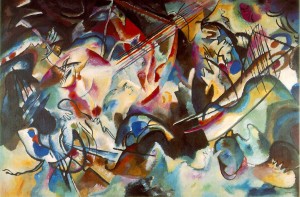Wassily Kandinsky, a Russian artist and art theorist, was one of the first painters noted as an abstract artist. He wrote On the Spiritual in Art in 1912 during the time in which he was a member of the artist group ‘The Blue Rider,’ a group of abstract painters who were planning on doing an exposition but was curtailed because of the onset of World War I. The language was one geared towards artists and those who were interested in understanding and observing art, using terms and phrases such as ‘observer,’ ‘inspiration,’ and ‘spiritual in art.’ Kandinsky’s intent was to help those less informed about art understand how to observe art and what it takes to create a truly ‘inspired’ work. Kandinsky’s message ultimately was that “”Understanding” is the approach of the observer to the to the artist’s viewpoint” ((Kandinsky, On the Spiritual in Art, 1946)), which further explicates the concept that observers must do their best to see the art from an artist’s perspective.
Inspiration for art in itself is a very abstract concept; one in which I probably will never understand. Learning about this concept of inspiration and understanding art was incredibly fascinating to read about, especially Kandinsky’s assumption that “Each painting mysteriously contains an entire life, a life of many sufferings, hours of doubts, of enthusiasm and of delighted inspiration” ((Kandinsky, On the Spiritual in Art, 1946)). This statement helped me understand the agony and jubilation an artist may experience during the process of trying to find inspiration in the world around him.
It made me think of how much that inspiration truly matters in the real world no matter what our field is; be it to better the field or find a better life, every person must have inspiration behind their passion. Because without inspiration, there is no ‘soul’ in whatever one strives to accomplish; it is without base or foundation.
My question: what do you think inspiration came from during this time period (the early 1900s)? Have these same things changed throughout time? How could an artist’s inspiration differ from a professor’s, for example?



